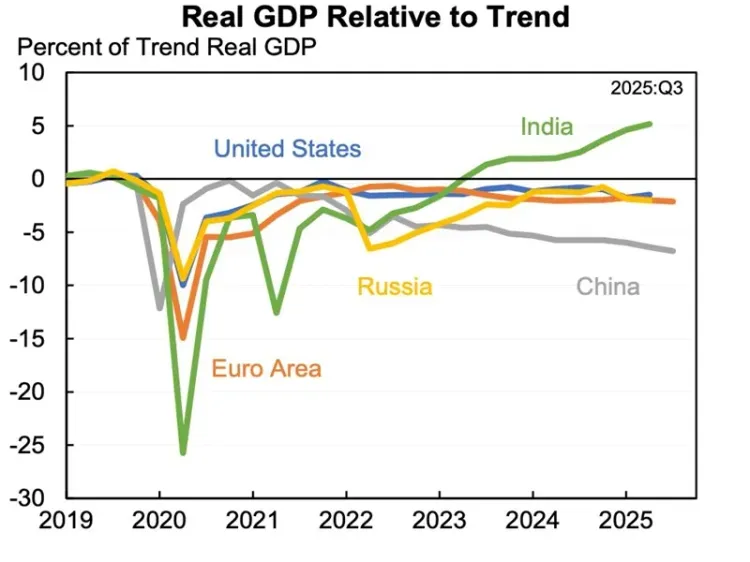Is India the Only Major Economy Surpassing Pre-Covid Growth Trends?

Synopsis
Key Takeaways
- India's GDP growth outpaces major economies.
- Projected growth of +5% by mid-2025.
- Strong domestic policies foster resilience.
- Digital infrastructure and youthful demographics are key contributors.
- India is aiming for a $5 trillion GDP by 2027.
New Delhi, Nov 22 (NationPress) In a remarkable showcase of economic resilience, Harvard Professor Jason Furman has identified India as the global leader in real GDP growth since the onset of the Covid-19 pandemic, outpacing even economic giants like the US and China.
A striking graph shared by Furman illustrates real GDP as a percentage of pre-pandemic trajectories from 2019 through Q3 of 2025; while numerous major economies continue to struggle with the lasting impacts of the 2020 recession, India's growth trajectory consistently rises, surpassing the zero baseline and aiming for +5 percent by mid-2025.
The chart referenced by Furman tracks five key economies: the United States (blue), Euro Area (green), China (gray), Russia (orange), and India (green -- easily recognized for its upward growth).
In 2020, all nations experienced a downturn, with the Euro Area dropping to -25 percent, the US to -5 percent, and China to -10 percent.
However, recovery paths diverged significantly afterward.
The US rebounded quickly, stabilizing around +2 percent by 2025, supported by substantial fiscal measures such as the American Rescue Plan, which Furman credits for minimizing 'scarring' compared to weaker responses elsewhere.
Nevertheless, India's growth is without parallel.
From a low of -5 percent in 2020, India's GDP relative to trend soared past pre-Covid levels by 2022, hitting +3 percent in 2024 and projected to achieve +5 percent in Q3 2025.
This positions India as the sole economy not only recovering but significantly exceeding its long-term growth trajectory, a success Furman attributes to structural strengths rather than temporary boosts.
Furman highlighted, 'India's policies have encouraged domestic consumption and investment in the face of global challenges,' contrasting it with Europe's energy crises and China's real estate troubles.
For instance, China's gray line stabilizes at -5 percent by 2025, hindered by zero-Covid lockdowns and real estate difficulties.
Russia's orange curve remains flat near -8 percent, impacted by post-Ukraine invasion sanctions.
The Euro Area, still at -3 percent, is grappling with inflation and geopolitical consequences.
Even the US, though strong, is heavily reliant on AI-driven data center investments, which account for 92 percent of first-half 2025 growth, according to Furman's estimates, raising concerns about sustainability.
Economists regard India's acceleration as a model for emerging markets.
Strong digital infrastructure, a youthful demographic dividend, and reforms like production-linked incentives have driven annual growth of 7-8 percent, according to IMF estimates.
Record highs in electronics and pharmaceuticals exports, along with resilient IT outsourcing services, have withstood global slowdowns. Moreover, the prudent fiscal policies of the Indian government have kept fiscal deficits below 6 percent of GDP, enabling targeted spending on infrastructure and social safety nets.
Furman's graph signifies a crucial shift; while advanced economies flirt with stagnation, India aims for a $5 trillion GDP by 2027.
Furman noted amid US fiscal policy discussions, 'Most countries saw quick rebounds, but few truly outgrew the trauma. India leads that group.' As 2025 approaches, the chart's implication is evident -- resilience is not just about recovery; it's about reshaping the future.









